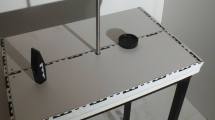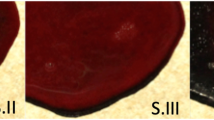Abstract
For investigative purposes, the bloodstain pattern analyst might have to estimate whether a given stain on fabric could have originated from a specific location. A wide range of values of the maximum distance that a blood drop can travel have been reported based on experiments, ranging from less than 1 m to more than 10 m. It is also known that stains on porous materials such as fabrics are more difficult to interpret than stains on non-absorbing surfaces, because of wicking. Here, we perform several fluid dynamic spatter experiments and formulate a fluid dynamics model to describe the trajectories of the blood drops. The experiments are performed with swine blood, the properties of which are well understood. The main parameters screened are the drop size, initial velocity, the launch angle, and the orientation of the fabric. A large number of blood drops are produced by impact events. The resulting stains on knitted white T-shirt fabric are digitally measured. Their position relative to the source and size is reported. Trajectories are simulated accounting for the influence of gravity and drag forces. A simple relation between drop size and stain size is established based on extensive experiments on a specific fabric. Results of the trajectory simulations are then searched and mined for parameters directly measurable on a crime scene, such as the stain size on fabric and the relative location of the fabric with respect to the blood source. The experimental results are compared and found in agreement with the numerical predictions. The results are presented in one chart relevant to crime scene reconstruction. The chart is easy to use and only requires minimum knowledge of fluid dynamics.
Graphic abstract











Similar content being viewed by others
Data availability
Data are described in manuscript.
References
Adam CD (2012) Fundamental studies of bloodstain formation and characteristics. Forensic Sci Int 219:76–87
Adam CD (2013) Experimental and theoretical studies of the spreading of bloodstains on painted surfaces. Forensic Sci Int 229(1–3):66–74
Agrawal P, Barnet L, Attinger D (2017) Bloodstains on woven fabric: Simulations and experiments for quantifying the uncertainty on the impact and directional angles. Forensic Sci Int 278:240–252
Anonymous (2007). literature search for the distance that backspatter travels. IABPA News 23(3): 31–32.
Arthur RM, Hoogenboom J, Baiker M, Taylor MC, de Bruin KG (2018) An automated approach to the classification of impact spatter and cast-off bloodstain patterns. Forensic Sci Int 289:310–319
Arthur RM, Humburg PJ, Hoogenboom J, Baiker M, Taylor MC, de Bruin KG (2017) An image-processing methodology for extracting bloodstain pattern features. Forensic Sci Int 277:122–132
ASTM (2015) ASTM D1777–96(2015) Standard Test Method for Thickness of Textile Materials. ASTM International, West Conshohocken, PA
Attinger, D. (2016). Development of a science base and open source software for bloodstain pattern analysis, Final technical report, 2010‐DN‐BX‐K403.
Attinger D (2019) Charts based on millions of fluid dynamics simulations provide a simple tool to estimate how far from its source a specific blood stain can be found. Forensic Sci Int 298:97–105
Attinger D, Liu Y, Bybee T, De Brabanter K (2018) A data set of bloodstain patterns for teaching and research in bloodstain pattern analysis: Impact beating spatters. Data Brief 18:648–654
Attinger D, Liu Y, De Brabanter K (2020) Authors’ Response. J Forensic Sci 65(4):1386–1387
Attinger D, Liu Y, Faflak R, Rao Y, Struttman BA, De Brabanter K, Comiskey PM, Yarin AL (2019) A data set of bloodstain patterns for teaching and research in bloodstain pattern analysis: gunshot backspatters. Data Brief 22:269–278
Attinger D, Moore C, Donaldson A, Jafari A, Stone HA (2013) Fluid dynamics topics in bloodstain pattern analysis: comparative review and research opportunities. Forensic Sci Int 231(1–3):375–396
Bevel T, Gardner RM (2008) Bloodstain pattern analysis with an introduction to crime scene reconstruction, 3rd edn. CRC Press, Boca Raton, FL, USA
Bockrath J, Lugo R (2017) Slugger slaying caught on tape. In: 2017 annual IABPA training conference (international association of bloodstain pattern analysts), Crown Plaza Redondo Beach and Marina.
Brindise MC, Busse MM, Vlachos PP (2018) Density and viscosity-matched Newtonian and non-Newtonian blood-analog solutions with PDMS refractive index. Exp Fluids 59(11):173
Buck U, Kneubuehl B (2012) Response to 3D bloodstain pattern analysis: Ballistic reconstruction of the trajectories of blood drops and determination of the centres of origin of the bloodstains by Buck et al. [Forensic Sci. Int. 206 (2011) 22–28]." Forensic Sci Int.
Camana F (2013) Determining the area of convergence in Bloodstain Pattern Analysis: A probabilistic approach. Forensic Sci Int 231(1–3):131–136
Chang JYM, Michielsen S (2016) Effect of fabric mounting method and backing material on bloodstain patterns of drip stains on textiles. Int J Legal Med 130(3):649–659
Chao TC, Trybala A, Starov V, Das DB (2014) Influence of haematocrit level on the kinetics of blood spreading on thin porous medium during dried blood spot sampling. Colloids Surf, A 451:38–47
Cho Y, Springer F, Tulleners FA, Ristenpart WD (2015) Quantitative bloodstain analysis: Differentiation of contact transfer patterns versus spatter patterns on fabric via microscopic inspection. Forensic Sci Int 249:233–240
Comiskey PM, Yarin AL (2018) Friction coefficient of an intact free liquid jet moving in air. Exp Fluids 59(4):65
Comiskey PM, Yarin AL (2019) Self-similar turbulent vortex rings: interaction of propellant gases with blood backspatter and the transport of gunshot residue. J Fluid Mech 876:859–880
Comiskey PM, Yarin AL, Attinger D (2017a) High-speed video analysis of forward and backward spattered blood droplets. Forensic Sci Int 276:134–141
Comiskey PM, Yarin AL, Attinger D (2017b) Hydrodynamics of back spatter by blunt bullet gunshot with a link to bloodstain pattern analysis. Physical Review Fluids 2(7):073906
Comiskey PM, Yarin AL, Attinger D (2018) Theoretical and experimental investigation of forward spatter of blood from a gunshot. Physical Review Fluids 3(6):063901
Comiskey PM, Yarin AL, Kim S, Attinger D (2016) Prediction of blood back spatter from a gunshot in bloodstain pattern analysis. Phys Rev Fluids 1(4):043201
Das R, Faflak R, Attinger D, Michael JB (2019) Blood atomization from blunt impact on a liquid film using high-speed digital in-line holography. In: ILASS-Americas 30th annual conference on liquid atomization and spray systems, Tempe, AZ: CD-ROM proceedings.
de Castro TC, Taylor MC, Carr DJ, Athens J, Kieser JA (2016) Storage life of whole porcine blood used for bloodstain pattern analysis. Canadian Soc Foren Sci J 49(1):26–37
Dicken L, Knock C, Carr DJ, Beckett S (2019) The effect of fabric mass per unit area and blood impact velocity on bloodstain morphology. Forensic Sci Int 301:12–27
Faflak R, Attinger D (2019) Bloodstain Pattern Analysis on US Military Fabrics (a report of 233 pages), Cooperative Agreement Number W911NF‐15‐2‐0111 with the U.S. Army Research Office and the Defense Forensic Science Center (DFSC) 233 p.
Feng C, Michielsen S, Attinger D (2018) Impact of carpet construction on fluid penetration: The case of blood. Forensic Sci Int 284:184–193
Forest PRD, Gaensslen RE, Lee HC (1983) Forensic science: An introduction to criminalistics. McGraw-Hill, New York
Grabmuller M, Cachee P, Madea B, Courts C (2016) How far does it get?–The effect of shooting distance and type of firearm on the simultaneous analysis of DNA and RNA from backspatter recovered from inside and outside surfaces of firearms. Forensic Sci Int 258:11–18
Hsiang LP, Faeth GM (1995) Drop deformation and breakup due to shock-wave and steady disturbances. Int J Multiph Flow 21(4):545–560
Hulse-Smith L, Mehdizadeh NZ, Chandra S (2005) Deducing drop size and impact velocity from circular bloodstains. J Forensic Sci 50(1):54–63
James SH, Kish PE, Sutton TP (2005) Principles of Bloodstain Pattern Analysis: Theory and Practice. CRC Press
Kabaliuk N, Jermy MC, Williams E, Laber TL, Taylor MC (2014) Experimental validation of a numerical model for predicting the trajectory of blood drops in typical crime scene conditions, including droplet deformation and breakup, with a study of the effect of indoor air currents and wind on typical spatter drop trajectories. Forensic Sci Int 245:107–120
Karger B, Nüsse R, Brinkmann B, Schroeder G, Wüstenbecker S (1996) Backspatter from experimental close-range shots to the head: 1. Macrobackspatter. Int J Legal Med 109(2):66–74
Karger B, Nüsse R, Tröger HD, Brinkmann B (1997) Backspatter from experimental close-range shots to the head: 2. Microbackspatter and the morphology of bloodstains. Int J Legal Med 110:27–30
Kim S, Ma Y, Agrawal P, Attinger D (2016) How important is it to consider target properties and hematocrit in bloodstain pattern analysis? Forensic Sci Int 266:178–184
Kolbasov A, Comiskey P, Sahu RP, Sinha-Ray S, Yarin AL, Sikarwar BS, Kim S, Jubery TZ, Attinger D (2016) Blood Rheology in Shear and Uniaxial Elongation. Rheol Acta 55:901–908
Kröll AK, Kettner M, Schmidt P, Ramsthaler F (2017) A novel experimental approach for classifying blood trails in relation to three different speeds of movement. Rechtsmedizin 27(6):528–535
Laan N, de Bruin KG, Slenter D, Wilhelm J, Jermy M, Bonn D (2015) Bloodstain pattern analysis: implementation of a fluid dynamic model for position determination of victims. Sci Rep 5:11461
Lansey JC (2015) Plot and compare histograms; pretty by default. https://www.mathworks.com/matlabcentral/fileexchange/27388-plot-and-compare-histograms-pretty-by-default
Liu Y, Attinger D, De Brabanter K (2020) Automatic classification of bloodstain patterns caused by gunshot and blunt impact at various distances. J Forensic Sci 65(3):729–743
Lockard, M. (2015). The fluid dynamics of droplet impacts on inclined surfaces with application to forensic blood-spatter analysis, MS Thesis, Georgia Tech.
MacDonell HL (2005) Bloodstain Patterns. Laboratory of Forensic Sciences, Corning, NY USA
Najjari MR, Hinke JA, Bulusu KV, Plesniak MW (2016) On the rheology of refractive-index-matched, non-Newtonian blood-analog fluids for PIV experiments. Exp Fluids 57(6):96
NRC (2009) Strengthening forensic science in the United States: A path forward, committee on identifying the needs of the Forensic Sciences Community, National Research Council (National Research Council. Washington, DC: The National Academies Press pp 177–179
Okawa T, Shiraishi T, Mori T (2006) Production of secondary drops during the single water drop impact onto a plane water surface. Exp Fluids 41(6):965–974
Pex JO, Vaughan CH (1987) Observations of high velocity bloodspatter on adjacent objects. J Forensic Sci 32(6):1587–1594
Rossi C, Herold LD, Bevel T, McCauley L, Guadarrama S (2018) Cranial backspatter pattern production utilizing human cadavers. J Forensic Sci 63(5):1526–1532
Scheller BL, Bousfield DW (1995) Newtonian drop impact with a solid surface. AIChE J 41(6):1357–1367
Shiri S, Martin KF, Bird JC (2018) Surface coatings including fingerprint residues can significantly alter the size and shape of bloodstains. Forensic Sci Int 295:189–198
Siu S, Pender J, Springer F, Tulleners F, Ristenpart W (2017) Quantitative differentiation of bloodstain patterns resulting from gunshot and blunt force impacts. J Forensic Sci 62(5):1–14
Stephens BG, Allen TB (1983) Back spatter of blood from gunshot wounds. Observations and experimental simulation. J Forensic Sci 28(2):437–439
Stotesbury T, Illes M, Wilson P, Vreugdenhil AJ (2017) The application of silicon sol-gel technology to forensic blood substitute development: Investigation of the spreading dynamics onto a paper surface. Forensic Sci Int 275:308–313
Vargas M (2013) Drag Coefficient of Water Droplets Approaching the Leading Edge of an Airfoil. In: 5th AIAA atmospheric and space environments conference pp 1–23, doi:https://doi.org/10.2514/2516.2013-3054.
Wang F, Gallardo V, Michielsen S, Fang T (2021) Fundamental study of porcine drip bloodstains on fabrics: Blood droplet impact and wicking dynamics. Forensic Sci Int 318:110614
Windberger U, Bartholovitsch A, Plasenzotti R, Korak KJ, Heinze G (2003) Whole blood viscosity, plasma viscosity and erythrocyte aggregation in nine mammalian species: reference values and comparison of data. Exp Physiol 88(3):431–440
Yousif MY, Holdsworth DW, Poepping TL (2011) A blood-mimicking fluid for particle image velocimetry with silicone vascular models. Exp Fluids 50(3):769–774
Acknowledgements
The authors acknowledge Dr. James Michael of Iowa State University for providing feedback on this manuscript.
Funding
US National Institute of Justice – Office of Justice Programs (award 2017DN-BX-017).
Author information
Authors and Affiliations
Corresponding author
Additional information
Publisher's Note
Springer Nature remains neutral with regard to jurisdictional claims in published maps and institutional affiliations.
Supplementary Information
Below is the link to the electronic supplementary material.
Rights and permissions
About this article
Cite this article
Faflak, R., Attinger, D. Experimental study of how far blood spatter stains on fabrics can be found from the blood source, and relevance to crime scene reconstruction. Exp Fluids 62, 87 (2021). https://doi.org/10.1007/s00348-021-03187-7
Received:
Revised:
Accepted:
Published:
DOI: https://doi.org/10.1007/s00348-021-03187-7




